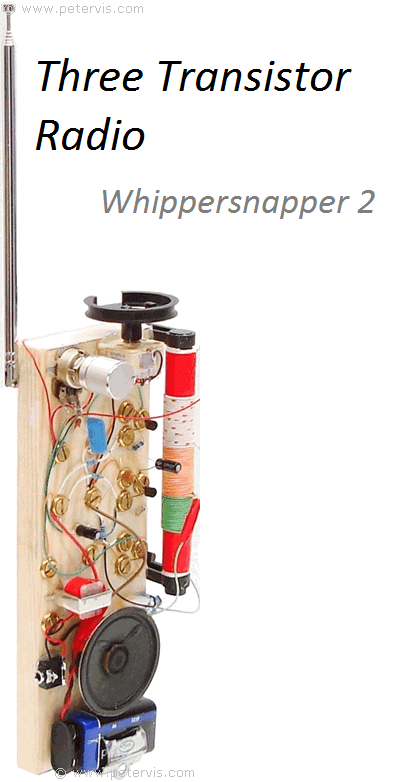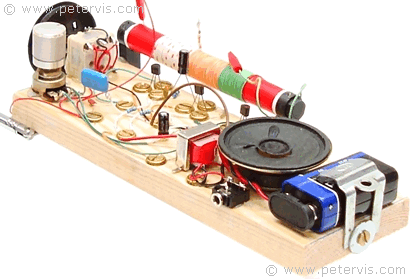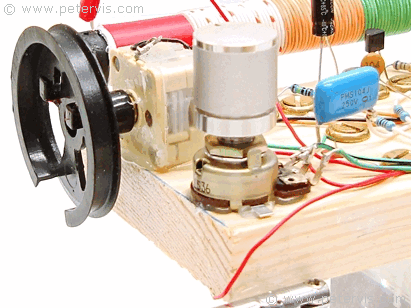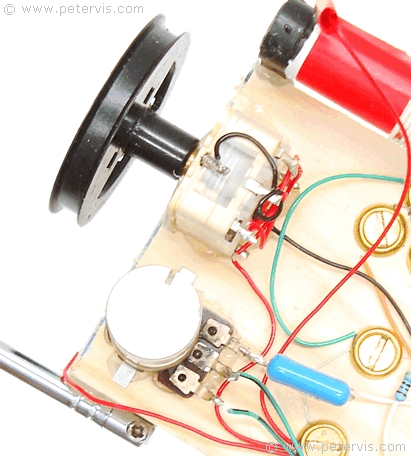Three Transistor Radio - Whippersnapper 2

This three-transistor AM pocket radio is extremely powerful because it uses MPSA13 Darlington transistors, where each transistor has a DC current gain (hFE) of 10,000. In addition, it uses the top-secret spy antenna coil with high-grade copper found in CAT 5 networking cable. A portable device such as this enables one to listen discretely to all sorts of radio signals, and whippersnappers throughout the world will be tuning into spy radio signals. If you cannot find a cheap LT700 transformer, then I have an alternative version of this radio Whippersnapper 3 that uses a power amplifier IC that is ear splitting loud.
Please note that this circuit is not for beginners. Ideally, you should have had considerable experience with building crystal radios first.
A general-purpose transistor such as the BC549C is not very efficient at amplifying fast radio frequency (RF) signals, because high frequency signals usually pass through without much effect, however when I was experimenting with some cheap transistors, I found that the MPSA13 worked extremely well for RF signals. The MPSA13 is a low-cost Darlington transistor that is readily available and is efficient at amplifying RF signals.
This is a wonderful portable radio, which hobbyists will want to make, because it is extremely simple to construct, and the parts I have selected are low-cost and readily found at places such as eBay. If you decide to use this with a pair of stereo headphones, then you should be able to enjoy high quality sound.


This radio design provides straightforward amplification of the radio signal, consequently you will hear whatever the aerial and ferrite antenna receive, and being portable, you can move the direction of the radio to receive the best signal. When listening through a good pair of headphones, I was surprised how clear the medium wave (MW) band actually is.
Although this is a three-transistor design, each transistor is a Darlington with a high gain, and therefore the reception is excellent. I tried many radio circuits designed by ‘experts’, however, my own design turned out to be the best. I suppose I should have had more faith in my own abilities!

The construction is extremely simple and clean. I am using a combination of techniques to reduce the cost and construction time. For the main circuit, I am using the screw cup system, which is the same as that in the Ladybird book radio. For mounting the tuning capacitor and the volume control, I am using the modern hot-glue gun with clear glue sticks. This technique also helps to eliminate any metal near the variable capacitor and ferrite rod.
Troubleshooting

Your success upon building this circuit depends upon your skill in radio electronics and the components you use. You should follow the circuit build and components closely. I have had bearded "professionals" use any old coil, and any old ferrite rod, and any old variable capacitor, and then email me that it did not work for them. If you consider yourself an "expert" and you use any old components then please do not email me, as you are well on the way to making your own radio design!
If you are having problems, then the first step is to test your ferrite coil and variable capacitor combination. Start by building a crystal radio using these components, and including a germanium diode and crystal earpiece. If you are able to receive stations, then and only then, continue further to building the transistor circuit. Ideally, you should build it one stage at a time and check for a signal at each stage using a crystal earpiece. This way, if you lose the signal, then you know which stage to focus on.
Remember, any old monkey can plug components into a breadboard blindly, but it takes a skilled engineer to build a circuit stage by stage. In the following pages of this article you can see the circuit diagram and an explanation of the stages.
This Article Continues...
Three Transistor Radio - Whippersnapper 2Circuit Diagram
Ferrite Coil Antenna
Loudspeaker and Transformer
Variable Capacitor
Baseboard Layout
Parts List
Completed Build
